GROUP 12 – 1958 BUICK FRAME AND SHEET METAL
12-1 CHECKING ALIGNMENT OF 1958 BUICK FRAME
Checking Alignment of 1958 Buick Frame and Suspension Members
When a 1958 Buick frame has been damaged by accident the following procedure may be used to check alignment of the 1958 Buick frame, and the alignment of the chassis suspension members with the frame. This procedure should also be used to check alignment after repairs to 1958 Buick frame have been completed.
Checks are to be made with 1958 Buick frame assembled with power plant, body, etc. and car resting on wheels. The car should be placed on a clean floor that is reasonably level. Both sides of the front ends of the 1958 Buick frame must be the same distance from the floor; the same condition must exist at rear end of frame. Where points are to be extended to floor by use of a plumb bob, it is desirable to attach clean pieces of paper to floor with tacks or tape so that the points can be clearly marked. Apply brakes or block wheels so that car cannot move.
- Using a plumb bob, extend the following points to the floor and mark where point of plum bob touches floor, as shown in figure 12-1.
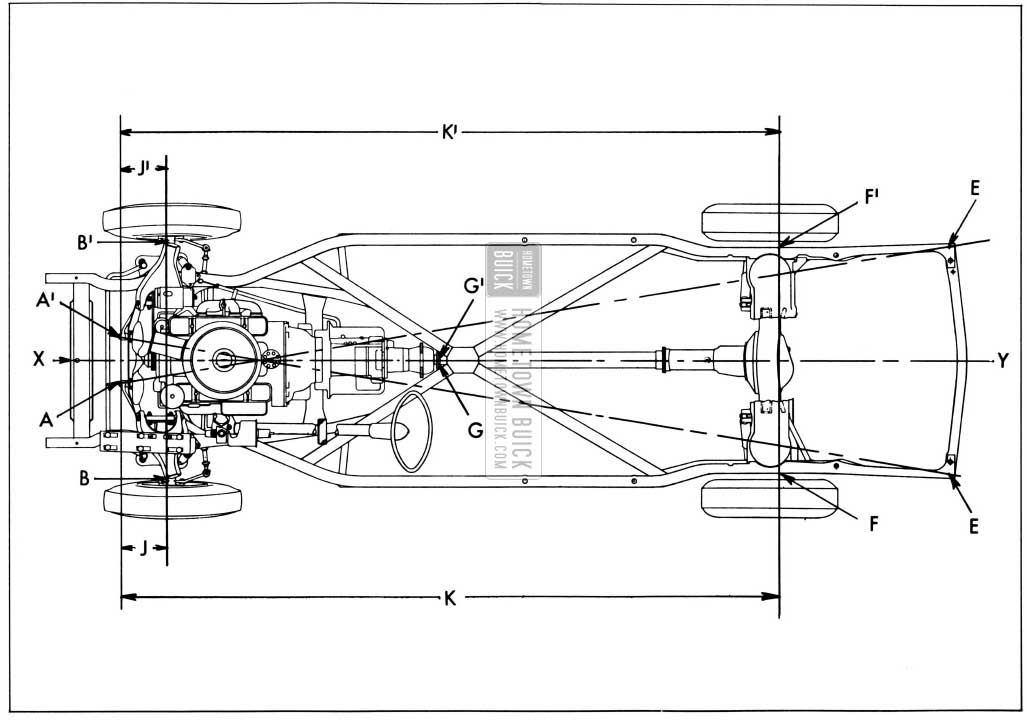
1958 Buick Checking Frame and Suspension Alignment
- A and A1 at center of grease fitting holes in front ends of lower control arm shaft bushings.
- B and B1 at sharp corner at forward outboard edge of lower ball joint plate.
- X at center of bolt hole in center of sheet metal support cross member (centerline of 1958 Buick frame).
- E and E1 at center of corner rivets attaching rear bumper cross member to side rails.
- F and F1 on side rails just rearward of rear axle housing, holding plumb line flat against side rails.
- G and G1 at each side of torque tube flange.
- Move car out of the way. Using a chalked line, draw lines on the floor through the following points: A and A1, B and B1, F and F1.
- Divide the distance between F and F1 and mark the center point Y on line F-F1. Draw frame centerline through points X and Y.
- Measure diagonal distances A to E1 and A1 to E. If these diagonals are not equal within 3/16” the 1958 Buick frame is bent.
- Measure the distances J and J1. If these are not equal within 1/4″ a lower control arm is bent.
- Measure the distances K and K1, which will be equal within 3/16″ if rear axle is not bent and is properly aligned with 1958 Buick frame. Points G and Gt should be equally distant from vehicle centerline X-Y. If distances K and K1 are not equal within 3/16″ and points G and G1 are equally distant from centerline, a bent rear axle housing or torque tube is indicated. If points G and G1 are not equally distant from centerline, look for misalignment of engine in the 1958 Buick frame.
Checking Alignment of 1958 Buick Frame Only
When a 1958 Buick frame has been damaged by accident and the power plant, body, etc., are removed, the measurements shown in figure 12-2 or 12-3 may be used to check for alignment of frame members. The procedure should also be used to check alignment after repairs to 1958 Buick frame have been completed.
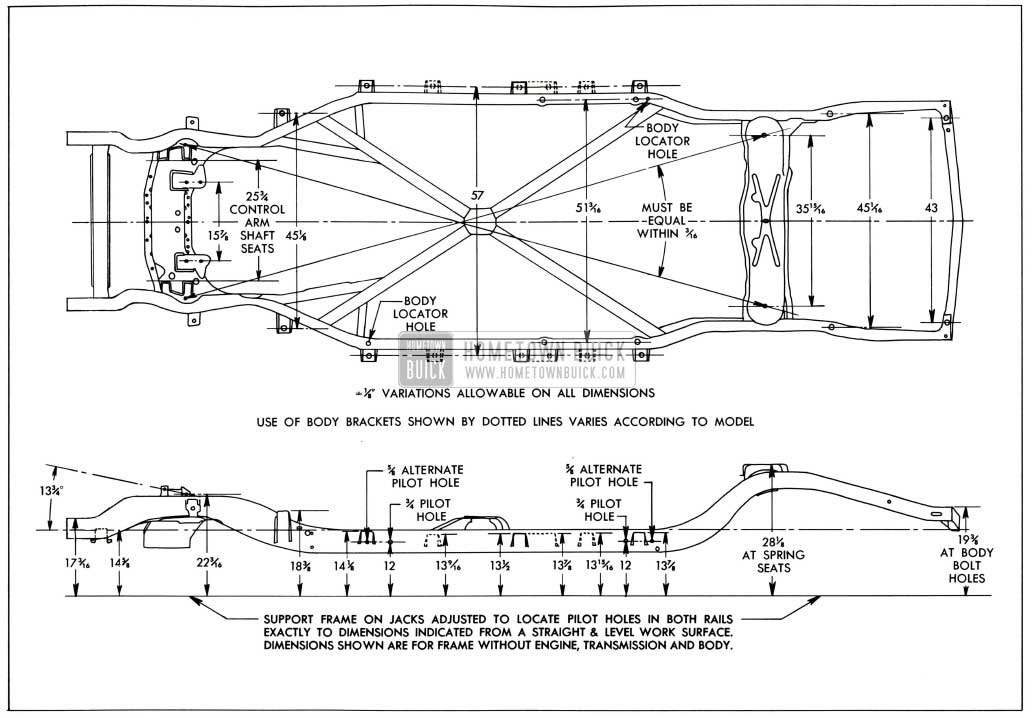
1958 Buick Frame Checking Dimensions-Series 40-60
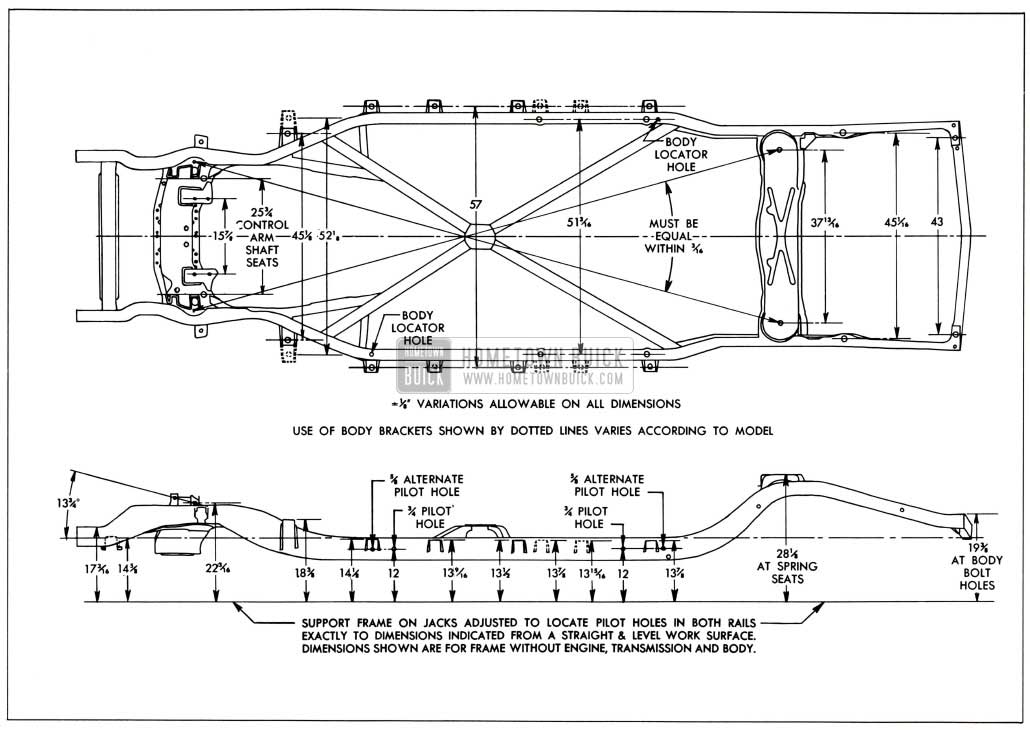
1958 Buick Frame Checking Dimensions-Series 50-70
The 1958 Buick frame must be solidly supported on suitable stands so that the pilot holes in both side rails are exactly at distance indicated from a straight and level work surface. Note that alternate pilot holes of different size and location may be found.
12-2 1958 BUICK FRAME REPAIRS
Straightening and Welding
In case of 1958 Buick frame distortion resulting from an accident it is permissible to straighten or weld the 1958 Buick frame if the distortion is not excessive.
Heat can be applied without materially weakening the steel, provided this is kept below 1200°F. This is a deep cherry red when viewed in subdued daylight, as in an average shop. Heat in excess of 1200°F. will weaken the metal structure and lead to eventual failure in service.
Replacement of 1958 Buick Frame Members
If a 1958 Buick frame front cross member is very badly distorted as a result of a front end collision, replacement is advisable because its rigid box construction makes proper straightening very difficult. Since the front suspension members are mounted on the frame front cross member, front end alignment will be affected if the cross member is not in perfect alignment.
The front end and rear cross members, rear spring support cross member, and a number of braces and brackets are available for service replacement. The old members may be removed from the 1958 Buick frame by cutting the attaching rivets and welds, after removing other parts or assemblies to allow working space.
When installing new frame members use hot rivets since they can be properly driven with hand tools. Cold driven rivets are not recommended because they cannot be securely driven with hand riveting tools. In places where hot rivets cannot be installed it is permissible to use finished bolts snugly fitted in reamed holes. Use lockwasher with bolts and draw nuts up tight. Weld a new member to adjacent members in the same manner that the replaced member was welded.
After installation of any new frame member check the 1958 Buick frame for proper alignment as described in paragraph 12-1. After any repairs or replacements in front end of frame be sure to check front wheel alignment (par. 7-17).
12-3 1958 BUICK BODY MOUNTINGS
At each closed body mounting point a rubber shim is placed between the body and 1958 Buick frame, a rubber insulator washer is placed under the 1958 Buick frame side rail flange or hanger, and flat steel washers and a tubular spacer limit compression of the rubber parts to a predetermined amount as the body bolt is tightened. See figure 12-4. This form of mounting eliminates metal-to-metal transmission of road and chassis noise into the body.
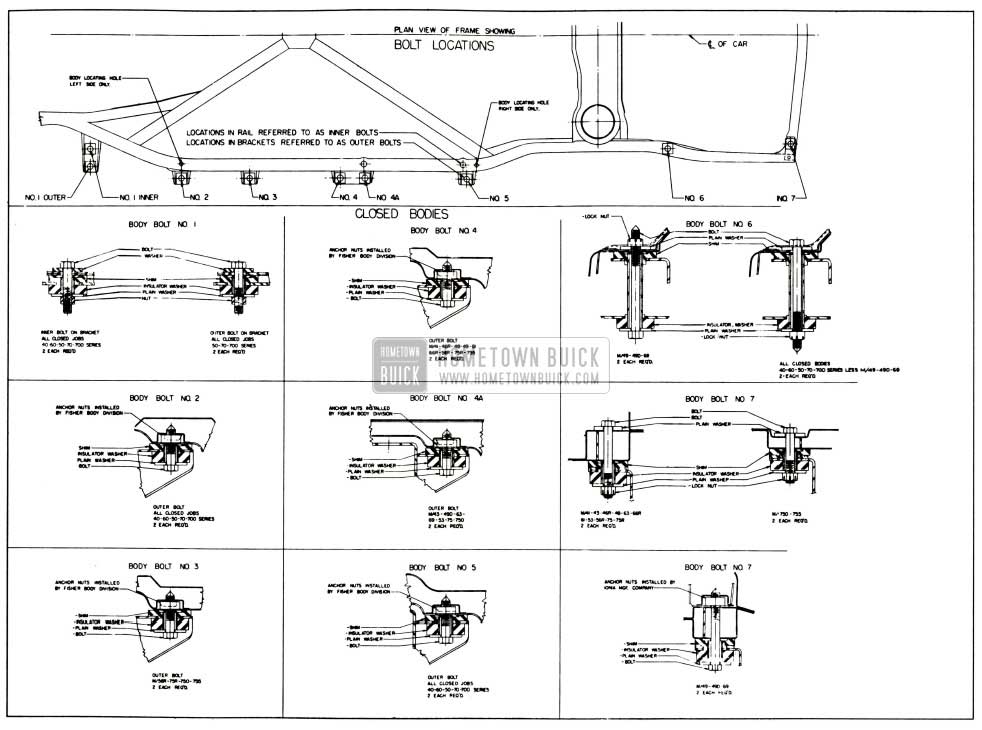
1958 Buick Body Mountings-Closed Bodies
At each convertible coupe mounting point a solid composition shim is placed between the body and the frame, and a flat washer and bolt anchors the body to the frame. See figure 12-5.
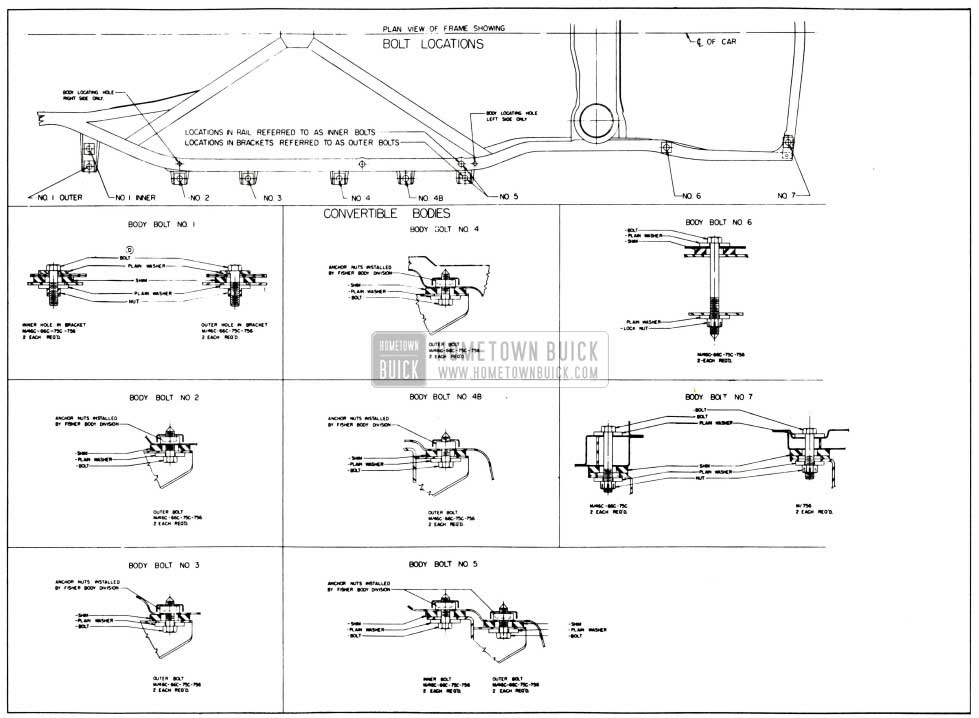
1958 Buick Body Mountings-Convertible Bodies
In addition to the parts shown in figures 12-4 and 5, steel shims are added as required at individual mountings to compensate for variations in body and frame in order to insure a firm mounting without distortion of body. Whenever it becomes necessary to remove body mountings, care must be taken to reinstall all of the mounting parts and steel shims in their exact original positions.
Closed bodies should not be re-shimmed to correct distortion of door openings. These openings should be shaped as required by the use of body jacks. The body should rest firmly on all mountings before bolts are tightened and steel shims should be added where body does not contact a mounting. Shims for this purpose are furnished under group 9.023.
Convertible bodies may be re-shimmed in cases where door locks do not latch securely after door is properly adjusted in body opening. In such cases, shims placed under the ends of body will close in the body door opening sufficiently to insure proper latching of door locks.
When 1958 Buick body bolts are tightened use a torque wrench to tighten all bolts uniformly to 25-30 ft. lbs. torque. The specified torque is very necessary to insure proper compression of convertible body mounting shims, and to insure tightening against the spacers in closed body mountings. Excessive tightening must be avoided as distortion of mountings will result.
12-4 DESCRIPTION OF 1958 BUICK SHEET METAL
1958 Buick Front End Sheet Metal Assembly
The 1958 Buick front end sheet metal assembly consists of fender skirts and tie bar, hood latch mounting panel, radiator grill, radiator pan, radiator core and mounting panel, fan shroud, horns and brackets, and lower gravel deflector. See figures 12-6 and 7.
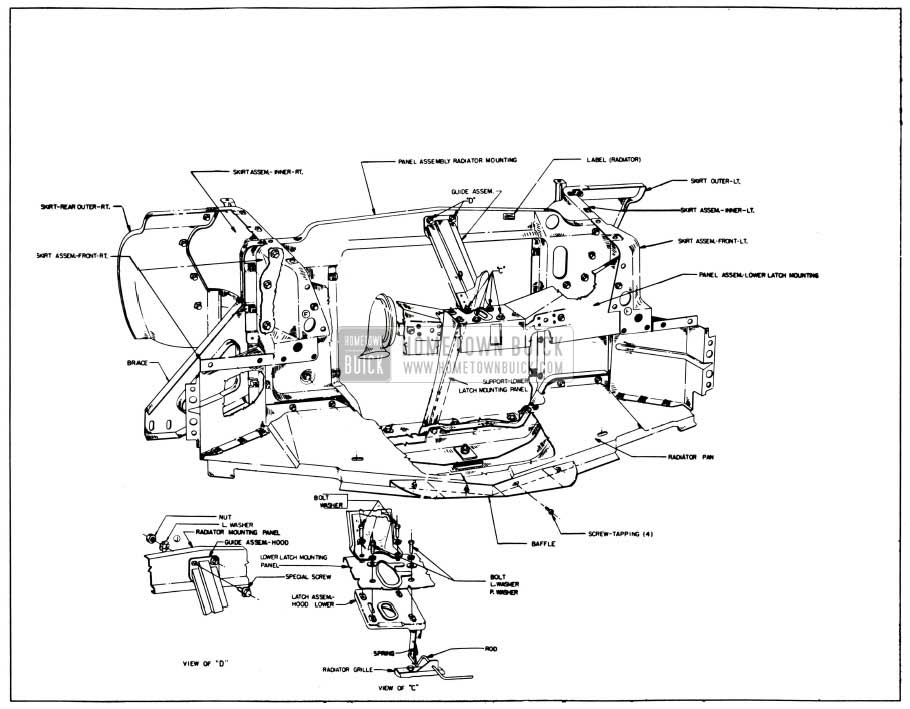
1958 Buick Front End Sheet Metal-Front View
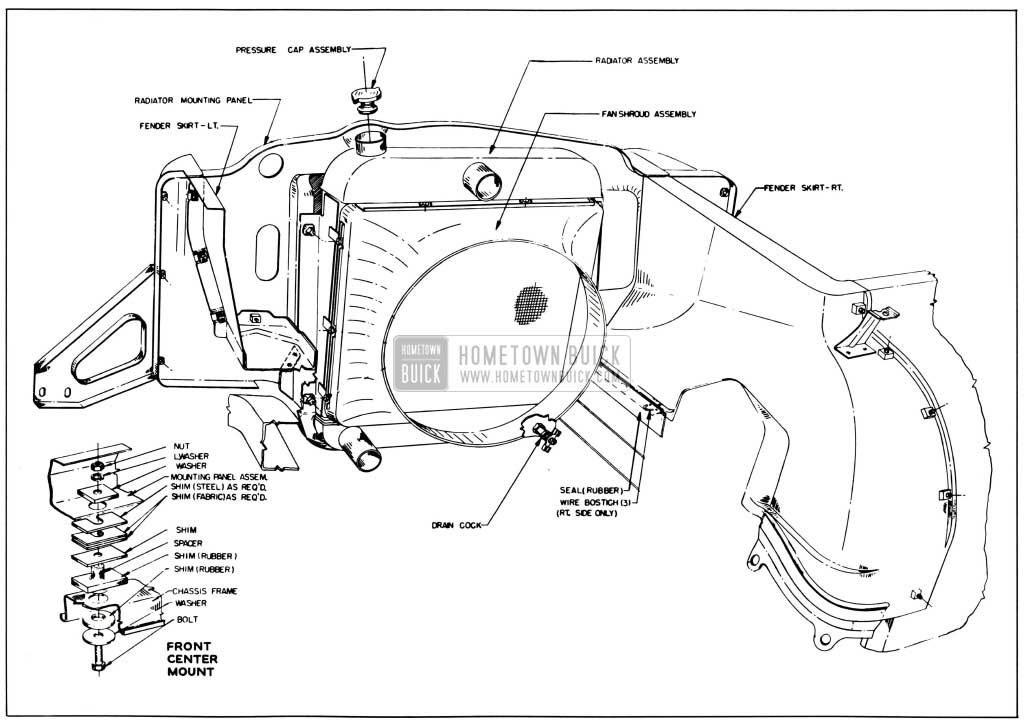
1958 Buick Front End Sheet Metal-Rear View
All front end sheet metal parts are joined together in an assembly that may be removed and installed as one unit, or the separate parts may be replaced without difficulty. The front of the sheet metal assembly is supported at the bottom of the radiator mounting panel. The radiator mounting panel is attached to a frame cross member by one bolt with insulating shims and washers to allow up and down adjustment at this point. See Figure 12-7. The rear ends of the front fenders are attached to the body cowl.
1958 Buick Hood, Hinges, and Latch Mechanism
The 1958 Buick hood panel is of one-piece construction which is strengthened and held to shape by front and rear transverse reinforcements of stamped sheet steel. The front end is also strengthened by a brace attached to the panel under the hood moulding to the center of the front reinforcement.
The rear end of the 1958 Buick hood is attached to the body cowl on each side by hinge assemblies which permit the front end of hood to be raised, alligator type. A heavy coil spring connected between each hinge assembly assists in raising the hood, and holds it in the open position. See figure 12-9.
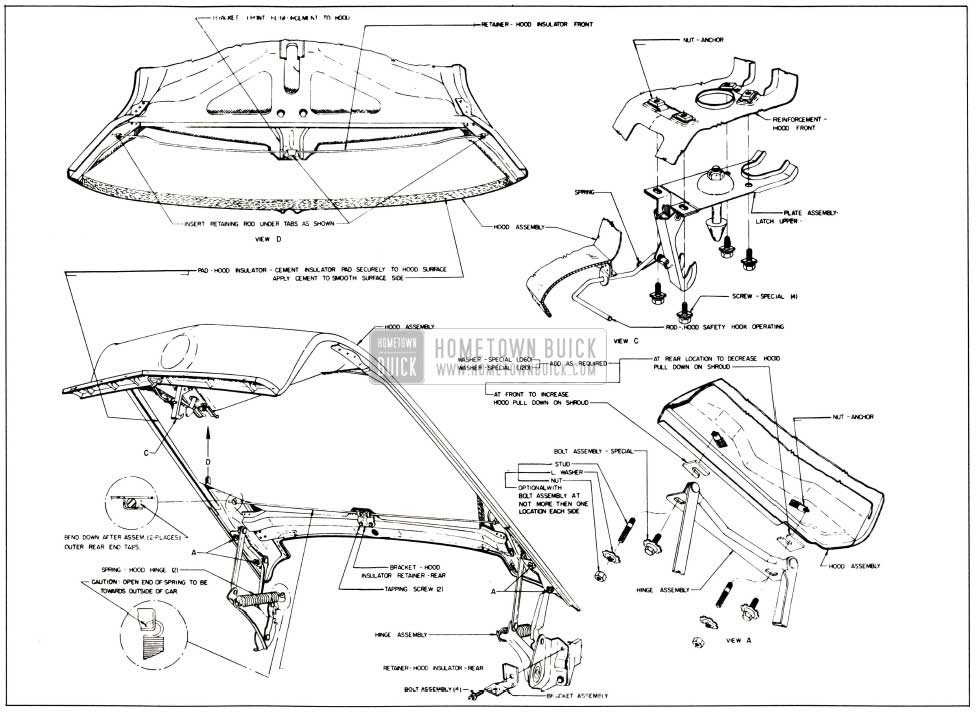
1958 Buick Hood Assembly
The front end of hood is locked down by a dovetail bolt on hood which engages a lock lever in the latch mounted on a panel of the front end sheet metal assembly (fig. 12-9). The 1958 Buick hood is unlocked by lifting a release lever located beneath radiator grille frame. A safety hook mounted on the hood must then be pulled forward before the hood can be raised.
12-5 1958 BUICK FENDER, BUMPER AND HOOD ALIGNMENT INSPECTION
The 1958 Buick hood, front fenders and bumper must be aligned with each other on every car to take care of slight variations in form and dimensions of the individual parts. Sheet metal parts stamped in a given set of dies will vary somewhat in form and dimensions due to variations in the hardness of different batches of sheet metal, which cause the stampings to spring in varying amounts when released from the form dies.
The 1958 Buick hood and front fenders are properly aligned during the installation at the factory; however, some readjustment may be required after a car has been shipped or has been in service for some time. This is because sheet metal parts may take a different “set” as a result of vibration and shock incident to shipping or operation during the break-in period. In judging the need for readjustment it must be understood that exactly uniform fit and spacing cannot be obtained on all cars of a given model.
1958 Buick Hood Noises or Panel Flutter
Squeaks or grunting noises in the hood when driving over rough roads do not necessarily indicate misalignment of hood and fenders. These noises may be caused by metal contact at some point where clearance should exist or by worn or dry hood bumpers.
If the 1958 Buick hood squeaks, check with 1/16″ thick feeler all around the hood for clearance at fenders and cowl. If an edge of metal is making contact at any point where clearance should exist a bright metal spot will usually be found. Such spots may be depressed by spring hammering to provide clearance.
A grunting noise in the hood is usually caused by dry rubber bumpers or cowl ledge lacing. Lubricate all rubber bumpers on fender rails and cowl with Lubriplate. To correct a persistent case of squeaking or grunting where hood top panel contacts ledge lacing, even when lubricated, cement a 1/16″ thick strip of felt to panel where the lacing makes contact.
To prevent hood panel flutter, the rear end of hood panel must have firm contact with the rubber lacing attached to cowl ledge. The hood may be raised or lowered by adjustment at hinges. See figure 12-9.
Preliminary Tightening
Before deciding upon any adjustment to correct hood or fender misalignment it is advisable to check tightness of all attaching screws and bolts, since a true picture of correction requirements cannot be obtained when the sheet metal is loose and free to shift.
After all parts are properly tightened inspect fender and hood alignment (subpar. c) and hood alignment (subpar. d). Make all inspections before performing any adjustments because an adjustment at one point will usually alter alignment at other points. The preliminary inspection should determine the adjustments that will produce the best overall alignment of hood and fenders at all points.
1958 Buick Fender and Hood Alignment at Front Doors
With front doors closed there should be no metal-to-metal contact between doors and rear ends of 1958 Buick front fenders. Check for clearance at frequent points, using a strip of fibre or other soft material 1/32″ thick. The spacing between rear end of front fenders and the shoulder on front edge of doors should be approximately 1/8″, and fairly uniform from top to bottom.
Before making any adjustment of sheet metal to provide necessary clearance at points mentioned, first make sure that front doors are properly aligned in the body openings. If fender and door panel surfaces are not reasonably flush, correction may be made by adding or removing shims between the fender and the cowl panel.
Where spacing between rear end of front fender and edge of door is objectionably uneven from top to bottom, it may be necessary to adjust the shims between radiator mounting panel and frame cross member or at points “A” “B” “C” or “D” shown in figure 12-8.
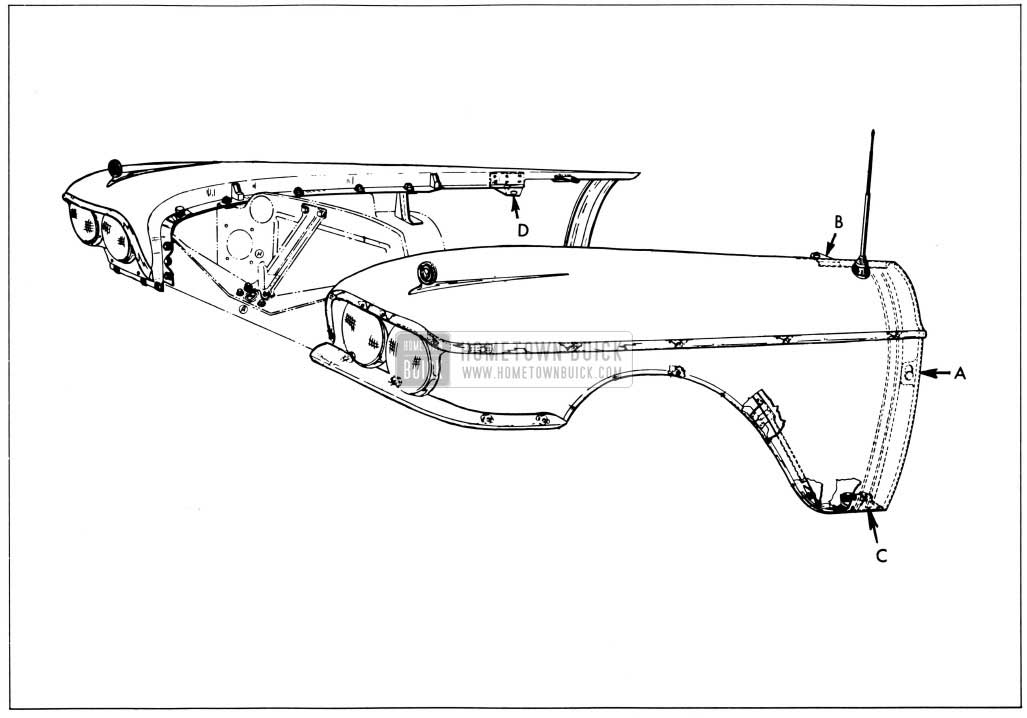
1958 Buick Front Fender Rear End Alignment Points
NOTE: The bolt at point “A” is accessible from inside the car just forward of the front door opening.
1958 Buick Hood alignment inspection
When closed and latched, the 1958 Buick hood should bear firmly against the front rubber bumpers on fender flange and the rubber lacing attached to the cowl ledge.
12-6 1958 BUICK FENDER, BUMPER AND HOOD ADJUSTMENT AND REPLACEMENT
1958 Buick Front fender and bumper adjustment
If the 1958 Buick front end of the sheet metal assembly is too high or too low, resulting in objectionably unequal vertical spacing between front fender or doors, it will be necessary to change the shims located under the radiator mounting panel. Adjustment of shims at points “A” “B” “C” or “D” in figure 12-8 also may be necessary if the front end sheet metal assembly is tilted to right or left so that proper alignment of hood, fenders and cowl cannot be obtained by hood adjustment.
The 1958 Buick bumper attaching holes in frame side rail, back bar and bumper face plate are slotted to permit movement of the bumper for proper alignment with adjacent parts.
Removal and Installation of 1958 Buick Hood Springs
- Support 1958 Buick hood in extreme “up” position, preferably by chain fall if available.
- To remove hood spring, insert Remover and Installer J-6325 through loop in forward end of spring with bend of tool approximately one inch from loop. Push tool toward rear of car, using inside corner formed by hinge as a pivot. Unseat spring from notch and move tool into notch.
- Then push tool forward, causing hood spring to slide clear of hinge.
- To replace hood spring, insert Remover and Installer J-6325 through loop in forward end of spring. Push tool rearward, using hinge as a pivot, and seat spring into notch.
Removal and Installation of 1958 Buick Hood Assembly
- Support 1958 Buick hood in extreme “up” position.
- Place folded rags under rear corners of hood to prevent possible damage to fenders.
- Scribe a reference line along edge of each hinge flange so hood can be replaced in same position.
- Remove four hood hinge to hood bolts.
- Lift 1958 Buick hood from car.
- To install, reverse above procedure.
1958 Buick Hood Adjustments
- Rear Height. This is determined by two adjustable bumpers. The rear of the 1958 Buick hood will always pull down to these bumpers. However, rear hood tension may also need adjusting as described in step 2.
A clearance of approximately 1/8″ should exist between each side of hood and the fender, and the spacing should be fairly uniform from front to rear. Along the sides, the hood and fender contours should be in reasonably close horizontal alignment.
A clearance of approximately 1/8″ should exist between the rear edge of hood and the shoulder of cowl panel, and the spacing should be fairly uniform from side to side.
Raise and lower the front end of hood slowly several times to check for proper alignment between the dovetail bolt in hood and the latch on sheet metal panel. Dovetail bolt should enter the opening in latch without any side strain or other interference. See figure 12-9.
- Rear Tension. Too little tension is indicated if the rear hood area flutters. To increase tension, add shims between the hood and the hinges at the front bolts. See figure 12-9.
Too much tension is indicated if the rear area of the hood bends as it is closed. To decrease tension, add shims between the 1958 Buick hood and the hinges at the rear bolts. See figure 12-9.
- Fore and Aft. The slotted bolt holes in the hinges allow the hood to be moved fore and aft. Before adjusting, scribe a reference line along the edge of each hinge flange. Then loosen the hinge to hood bolts and shift the hood from this line as required. To adjust the front end of the hood sideways, shift the hood at one hinge only.
- Front Height. This is determined by two adjustable bumpers. However, the front of the hood may not contact these bumpers unless the hood latch is correctly adjusted as described below.
- Latch Alignment. The 1958 Buick hood upper latch position cannot be shifted appreciably, therefore any adjustment must be made at the lower latch. Make sure that the hood is properly adjusted as described above, then loosen the six lower latch and guide mounting bolts. Close the hood, thereby causing the lower parts to shift into alignment with the upper parts. Open the hood and tighten the bolts, being careful not to disturb the lower latch and guide.
- Latch Tension. This is determined by the length of the latch bolt. If the front of the closed hood is not held tight against the bumpers, the latch bolt is adjusted too long. If the hood can’t be closed or is hard to close, the latch bolt may be adjusted too short.
To adjust the latch bolt, loosen the jam nut on the upper end and turn the bolt by means of the screwdriver slot in the lower end. Then tighten the jam nut and close the hood to recheck latch tension. See figure 12-9.

I NEED CHASSIS BUICK SUPER 1958.